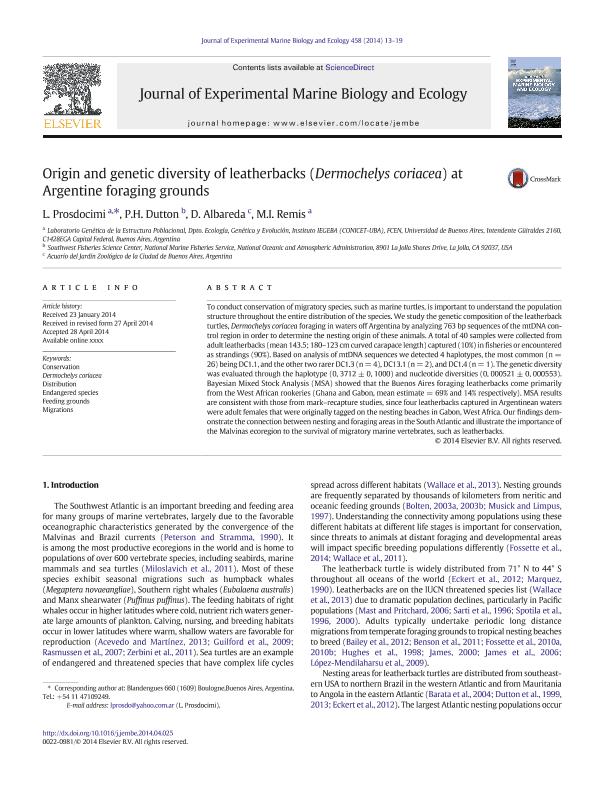Mostrar el registro sencillo del ítem
dc.contributor.author
Prosdocimi, Laura

dc.contributor.author
Dutton, P. H.
dc.contributor.author
Albareda, Diego
dc.contributor.author
Remis, Maria Isabel

dc.date.available
2017-07-06T20:08:46Z
dc.date.issued
2014-09
dc.identifier.citation
Prosdocimi, Laura; Dutton, P. H.; Albareda, Diego; Remis, Maria Isabel; Origin and genetic diversity of leatherbacks (Dermochelys coriacea) at Argentine foraging grounds; Elsevier Science; Journal of Experimental Marine Biology and Ecology; 458; 9-2014; 13-19
dc.identifier.issn
0022-0981
dc.identifier.uri
http://hdl.handle.net/11336/19805
dc.description.abstract
To conduct conservation of migratory species, such as marine turtles, is important to understand the population structure throughout the entire distribution of the species. We study the genetic composition of the leatherback turtles, Dermochelys coriacea foraging in waters off Argentina by analyzing 763 bp sequences of the mtDNA control region in order to determine the nesting origin of these animals. A total of 40 samples were collected from adult leatherbacks (mean 143.5; 180–123 cm curved carapace length) captured (10%) in fisheries or encountered as strandings (90%). Based on analysis of mtDNA sequences we detected 4 haplotypes, the most common (n = 26) being DC1.1, and the other two rarer DC1.3 (n = 4), DC13.1 (n = 2), and DC1.4 (n = 1). The genetic diversity was evaluated through the haplotype (0, 3712 ± 0, 1000) and nucleotide diversities (0, 000521 ± 0, 000553). Bayesian Mixed Stock Analysis (MSA) showed that the Buenos Aires foraging leatherbacks come primarily from the West African rookeries (Ghana and Gabon, mean estimate = 69% and 14% respectively). MSA results are consistent with those from mark–recapture studies, since four leatherbacks captured in Argentinean waters were adult females that were originally tagged on the nesting beaches in Gabon, West Africa. Our findings demonstrate the connection between nesting and foraging areas in the South Atlantic and illustrate the importance of the Malvinas ecoregion to the survival of migratory marine vertebrates, such as leatherbacks.
dc.format
application/pdf
dc.language.iso
eng
dc.publisher
Elsevier Science

dc.rights
info:eu-repo/semantics/openAccess
dc.rights.uri
https://creativecommons.org/licenses/by-nc-nd/2.5/ar/
dc.subject
Genetic Conservation
dc.subject
Dermochelys Coriacea
dc.subject
Endangered Species
dc.subject
Feeding And Development Ground
dc.subject.classification
Conservación de la Biodiversidad

dc.subject.classification
Ciencias Biológicas

dc.subject.classification
CIENCIAS NATURALES Y EXACTAS

dc.title
Origin and genetic diversity of leatherbacks (Dermochelys coriacea) at Argentine foraging grounds
dc.type
info:eu-repo/semantics/article
dc.type
info:ar-repo/semantics/artículo
dc.type
info:eu-repo/semantics/publishedVersion
dc.date.updated
2017-07-05T15:02:30Z
dc.journal.volume
458
dc.journal.pagination
13-19
dc.journal.pais
Países Bajos

dc.journal.ciudad
Amsterdam
dc.description.fil
Fil: Prosdocimi, Laura. Consejo Nacional de Investigaciones Científicas y Técnicas. Oficina de Coordinación Administrativa Ciudad Universitaria. Instituto de Ecología, Genética y Evolución de Buenos Aires. Universidad de Buenos Aires. Facultad de Ciencias Exactas y Naturales. Instituto de Ecología, Genética y Evolución de Buenos Aires; Argentina
dc.description.fil
Fil: Dutton, P. H.. National Ocean And Atmospheric Administration; Estados Unidos
dc.description.fil
Fil: Albareda, Diego. Ciudad Autónoma de Buenos Aires. Jardín Zoológico; Argentina
dc.description.fil
Fil: Remis, Maria Isabel. Consejo Nacional de Investigaciones Científicas y Técnicas. Oficina de Coordinación Administrativa Ciudad Universitaria. Instituto de Ecología, Genética y Evolución de Buenos Aires. Universidad de Buenos Aires. Facultad de Ciencias Exactas y Naturales. Instituto de Ecología, Genética y Evolución de Buenos Aires; Argentina
dc.journal.title
Journal of Experimental Marine Biology and Ecology

dc.relation.alternativeid
info:eu-repo/semantics/altIdentifier/doi/http://dx.doi.org/10.1016/j.jembe.2014.04.025
dc.relation.alternativeid
info:eu-repo/semantics/altIdentifier/url/http://www.sciencedirect.com/science/article/pii/S002209811400118X
Archivos asociados
